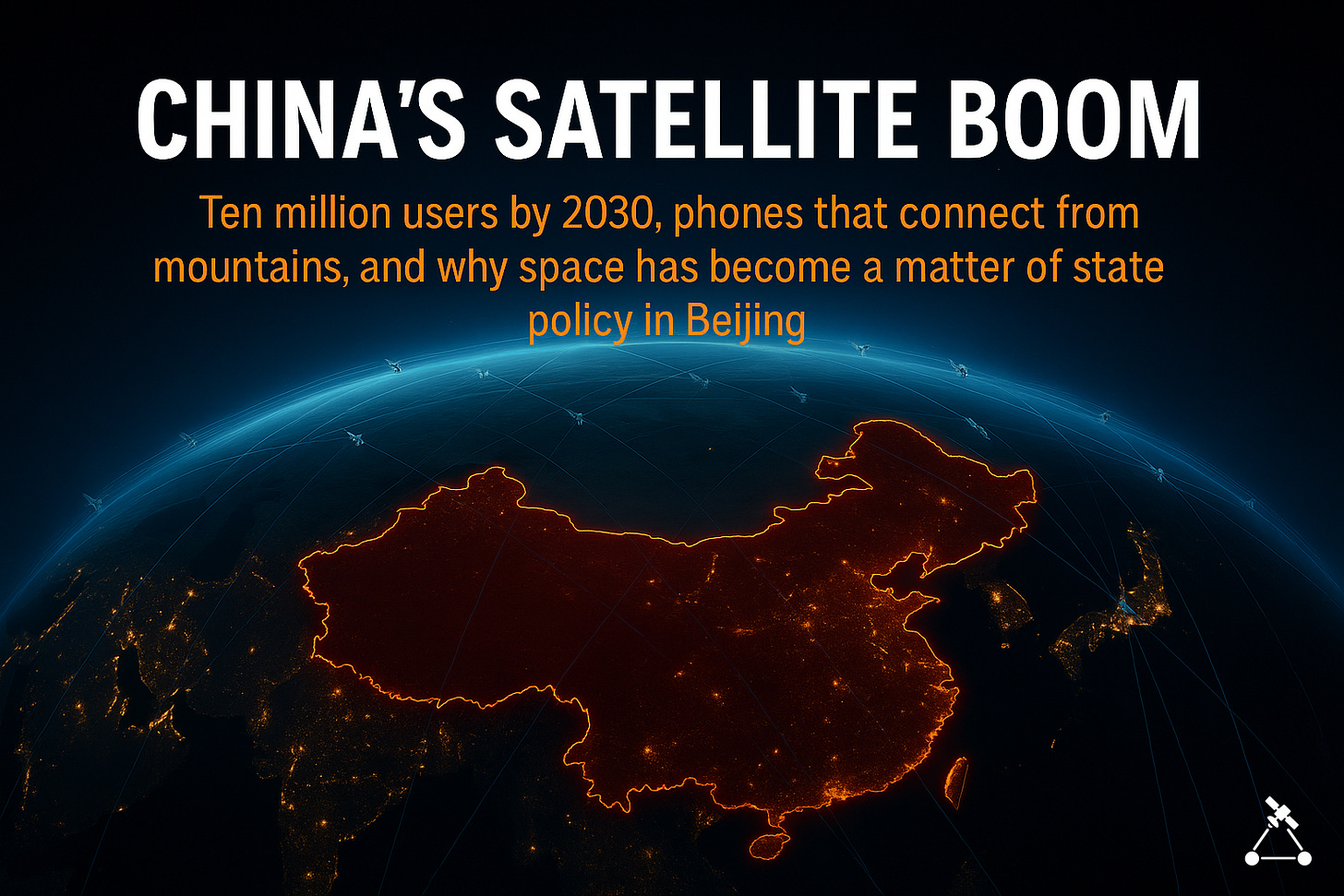China’s Satellite Boom
Ten million users by 2030, phones that connect from the mountains, and why space has become a matter of state policy in Beijing
China’s Satellite Boom
If the war in Ukraine taught the world anything, it’s this: satellite internet is no longer a luxury, it’s survival. Tens of thousands of Starlink terminals kept communications alive when almost everything else failed. Without them, the war would look very different today.
Beijing has been watching closely. And the takeaway is simple: space-based connectivity isn’t just a backup plan, it’s critical infrastructure. That’s why on August 25, 2025, China’s Ministry of Industry and Information Technology (MIIT) published a directive setting a very specific target: over 10 million satellite communication users by 2030.
Phones that talk to the sky
Imagine hiking in the mountains, no cell towers in sight. Normally, your phone would flash “No Service.” But instead it pings a satellite, and your text goes through as if you were downtown Beijing.
That’s the idea behind Direct-to-Device (D2D). The MIIT directive makes it explicit: the service should work “without requiring a new SIM card or phone number.” In other words, your phone silently switches from ground towers to satellites.
The first stage will be SMS and voice calls. But the directive already mentions a bigger goal: data services over low-earth orbit (LEO) satellites. Which means: full-blown internet, straight from orbit.
When even cows become subscribers
The second big focus is satellite IoT. The directive specifically calls for “pilot projects enabling mass-scale IoT via LEO satellites.”
Translation: not just people, but also things will become users. Trucks, shipping containers, energy grids, smart meters—and yes, even a cow with a GPS collar in Inner Mongolia. Each of these devices becomes a subscriber.
So when Beijing says “10 million users,” it’s really talking about people and things. Which makes that target far less far-fetched.
Constellations: bamboo in orbit
Of course, none of this works without thousands of satellites. That’s why MIIT is easing licensing for “space stations” and frequencies, paving the way for massive launches.
China already has multiple orbital “bamboo groves”:
Guo Wang (SatNet) — the state backbone.
Qianfan (G60) — nearly 100 satellites already up.
Geely/Geespace — yes, the car company; now also a satellite operator.
Tianqi — a narrowband IoT constellation.
…and others.
And the pace is dizzying. Like bamboo after rain: one day empty, the next a forest.
The innovation wave
The MIIT directive doesn’t just talk about satellites. It calls for “integration of satellite communications into the 5G/6G ecosystem, and the development of national data hubs and gateways.” Which means: this is about the entire tech stack.
Here’s what gets pulled into orbit:
Smartphone chips. Next-gen phones will ship with NTN modules by default.
Antennas. Forget dishes—flat phased arrays will become the norm, on cars, trains, and ships.
Ground gateways. Every swarm of satellites needs Earth-based “traffic hubs.”
Data centers. To route, process, and cache the tidal wave of data.
Laser links. Satellites talking to each other with light, making orbit a true internet backbone.
Rockets. More satellites = more launches = more factories, pads, and jobs.
In short: one line in a government plan (“10 million users”) pulls an entire industrial chain into motion.
Geopolitics with a dark twist
Now picture this: Moscow decides to actually follow through on Dmitry Medvedev’s drunken prophecies—detonating a nuclear device in orbit, triggering a cascade of dead satellites and space debris.
That wouldn’t just hit the West. It would cripple Chinese constellations too. And since MIIT has now made satellite communications part of critical national infrastructure, such a move would strike banks, energy, logistics, and state security.
One can only imagine the look on Beijing’s leadership if Moscow ever tried. Let’s just say: “strategic partner” might no longer be the label of choice.
The road to 2030
Is 10 million realistic? MIIT calls it an “industry development benchmark.” Depending on how the next five years unfold:
Baseline: 10–15 million users.
Cautious: 6–9 million (if chips or standards lag).
Optimistic: 15–25 million (if modules get cheap and launches stay aggressive).
But the bigger point is clear: satellite internet in China will no longer be exotic. It will be as mundane as mobile coverage. And maybe—just maybe—Beijing will be the first to show the world what a mass-market orbital network looks like.
Sources
https://www.miit.gov.cn
https://www.xinhuanet.com
https://tv.cctv.com
https://paper.people.com.cn
https://www.yicai.com
https://finance.sina.com.cn



